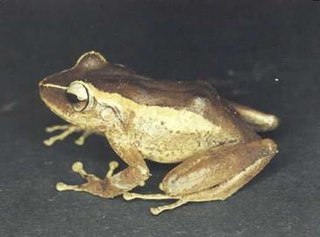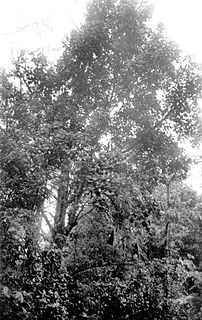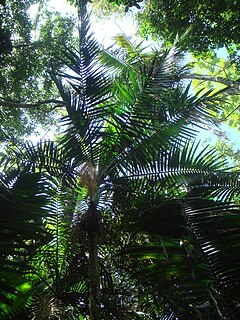
Cordillera Central, is the main mountain range in Puerto Rico. The range crosses the island from west to east and divides the island into northern and southern coastal plains.

Eleutherodactylus portoricensis is a frog native to Puerto Rico that belongs to the family Eleutherodactylidae. Its vernacular English names are upland coqui, mountain coqui, and Puerto Rican robber frog. It is found in the Toro Negro State Forest and other similar mountainous regions.

Dacryodes excelsa is a tree native to Puerto Rico with a habitat that extends into the Lesser Antilles in the Caribbean region. Its English vernacular names include gommier and candlewood. Its Spanish common name is tabonuco. According to Richards, "it is the most conspicuous large emergent tree" in the Luqillo mountains of Puerto Rico. It is also found in Toro Negro State Forest, in Puerto Rico Cordillera Central.

Toro Negro State Forest is one of the 21 forests that make up the public forests system in Puerto Rico. It is also Puerto Rico's highest cloud forest. It is located in the Cordillera Central region of the island and covers 8,204 cuerdas, of mountains. Toro Negro's mountains have heights reaching up to 4,400 feet (1,300 m) and include Cerro de Punta, Cerro Jayuya and Cerro Rosa, the three highest peaks in the island. Nested among these mountains is Lake Guineo, the island's highest lake. The forest has 18 kilometers (11 mi) of trails, an observation tower, two natural swimming pools (Spanish:"charcos"), camping and picnic areas, nine rivers, and numerous creeks and waterfalls. The forest spans areas within the municipalities of Ponce, Jayuya, Orocovis, Ciales, and Juana Díaz, and consists of seven non-contiguous tracts of land. The largest contiguous segment of the forest is located in the municipalities of Ponce and Jayuya. Some 40% of the area of Toro Negro State Forest is located in Ponce's Barrio Anón.

Anón River is a river in the municipality of Ponce, Puerto Rico. It is located in the northeastern area of the municipality. Río Anón is one of the 14 rivers in the municipality and, at 1,060 feet (320 m), it is also the third with the highest river mouth location, after Río Prieto and Río Blanco, both of which have their mouths at 1,381 feet (421 m). Río Anón is a tributary of Río Inabón. It has a length of approximately 4 kilometers (2.5 mi) and generally runs south. It has both its origin and its mouth in Barrio Anón.

Río Blanco is a river in the municipality of Ponce, Puerto Rico. It is located in the northeastern area of the municipality. It empties into the Río Prieto. Together with the Río Prieto, the Río Blanco is one of the two rivers in Ponce with their mouth at the highest elevation. This river is one of the 14 rivers in the municipality.

The Puerto Rican sharp-shinned hawk, (Accipiter striatus venator), falcón de sierra or gavilán pecho rufo in Spanish, is an endemic subspecies of the North American sharp-shinned hawk, occurring only in Puerto Rico. Discovered in 1912 and described as a distinct sub-species, it has been placed on the United States Fish and Wildlife Service list of endangered species because of its rapidly dwindling population in Puerto Rico. It can be found in the Toro Negro State Forest.
Amauropelta inabonensis, synonym Thelypteris inabonensis, is a rare species of fern known by the common name cordillera maiden fern. It is endemic to Puerto Rico, where it is known from only two localities: at the headwaters of Río Inabón and at the Toro Negro State Forest. It is a federally listed endangered species of the United States.

Magnolia portoricensis is a tree of the Caribbean region. Its vernacular names include jagüilla and Puerto Rico magnolia. It is native to Puerto Rico and it is found in the Toro Negro State Forest. It is an endangered tree and endemic to Puerto Rico. It is a dicot and a part of the family Magnoliaceae. It is an uncommon tree, found primarily in the central and western mountains at 500 to 925 m above sea level.

Cerrillos State Forest is one of the 21 state forests in Puerto Rico. It is located in barrio Maragüez, in the municipality of Ponce, and covers 200 cuerdas of valleys and mountains. The forest has several trails, observation areas, several picnic areas, complete with gazeebos and a man-made reservoir, Lake Cerrillos and the Lake Cerrillos dam.
Vitex divaricata is a tree shrub of the Caribbean native to Puerto Rico and the US Virgin Islands. Its Spanish vernacular names include higüerillo and higuerillo. Its English vernacular name is white fiddlewood. It belongs to the order Lamiales. This tree is common in the Toro Negro State Forest.

Anolis cuvieri is a species of lizard in the family Dactyloidae. The species is endemic to Puerto Rico, and is common in the Toro Negro State Forest.
Prunus occidentalis is a plant in the family Rosaceae of the order Rosales. The plant can be found in the Caribbean, Central America and northern South America. It is commonly found in Puerto Rico. Its Spanish common names include almendrón. Its English common name is the western cherry laurel. The plant is common in the Toro Negro State Forest.

Atya lanipes is a freshwater amphidromous shrimp of the Atyidae family in the Decapoda order. It is found widely in the Caribbean and is common in the Toro Negro State Forest in central Puerto Rico. It is also known as jonga and in some places people refer to it as "guábara” or “chágara”.

Prestoea montana is a perennial palm in the family Arecaceae. It is considered a synonym of Prestoea acuminata var. montana.

The mountain mullet is a freshwater fish of the family Mugilidae in the Mugiliformes order. It can be found in North and South America, from North Carolina, Florida, Louisiana and Texas in the United States to Colombia and Venezuela, including the West Indies in the Antilles. It is the only species in the monospecific genus Dajaus.

Pouteria multiflora is a plant in the family Sapotaceae of the order Ericales. Its English common name is bullytree. Its Spanish common names include jácana, ácana, acana, hacana, or jacana. It is native to North and South America. The plant is common in the Toro Negro State Forest.

The Puerto Rican broad-winged hawk is an endangered subspecies of the broad-winged hawk. It is a small hawk that occurs in Puerto Rico, inhabiting the Toro Negro State Forest. Its Spanish common name is guaragüao de bosque.
Macrobrachium crenulatum is an amphidromous freshwater shrimp of the Palaemonidae family in the Decapoda order. It is found in lowland rivers and streams from Panama to Venezuela, as well as on several Caribbean islands. The species is common in the Toro Negro State Forest in central Puerto Rico. Studies have shown that the species have higher sensitivity to environmental, hydrological and chemical factors than other crustaceans also studied and which affect its migratory patterns.













